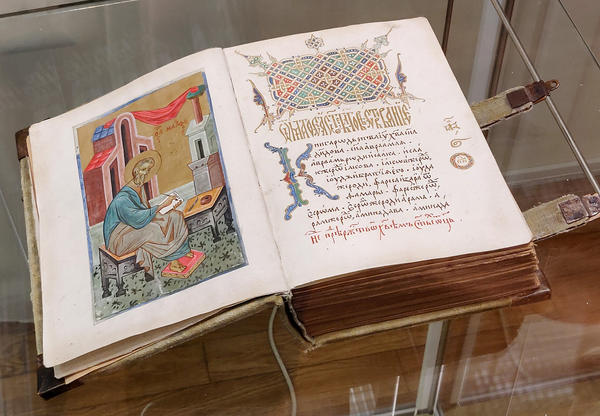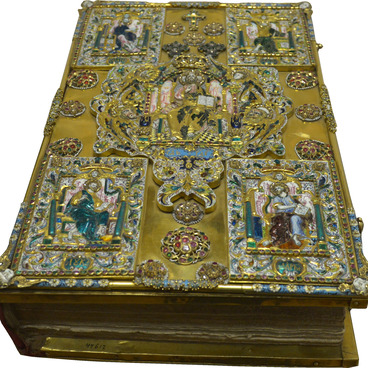The Gospel Book on display was written in the Principality of Tver in 1478, i.e. in the late years of its independence. Seven years later, following the collapse of the Golden Horde, the principality became part of united Moscovy.
The book consists of 322 pages. It combines the Four Gospels of the New Testament and the Aprakos, i.e. readings arranged in the calendar order. The Gospel Book was written in the half-uncial style – a more rounded version of the Cyrillic writing font. All entries are accompanied by colourful vignettes and medallions. Pages are also decorated with coloured entries, initials and miniature pictures.
The Gospel Book covered with yellow velvet is partially enclosed in a metal cover with shaped plates, knops and corner pieces. The edging is decorated with embossing. Copper locks on leather straps tightly fix the book binding covers.
The original binding cover of this Tver Gospel Book was lost. In the 18th century, it was renovated while keeping the gold-covered silver plates going back to the 15th century with embossed images of the four Gospel writers and a crucifix.
Analysts believe that this tome was written by Bassian, Bishop of Tver, in the worldly life known as Prince Vasily Strigin-Obolensky. His authorship is evidenced by the record made on the reverse side of the last page,
The book consists of 322 pages. It combines the Four Gospels of the New Testament and the Aprakos, i.e. readings arranged in the calendar order. The Gospel Book was written in the half-uncial style – a more rounded version of the Cyrillic writing font. All entries are accompanied by colourful vignettes and medallions. Pages are also decorated with coloured entries, initials and miniature pictures.
The Gospel Book covered with yellow velvet is partially enclosed in a metal cover with shaped plates, knops and corner pieces. The edging is decorated with embossing. Copper locks on leather straps tightly fix the book binding covers.
The original binding cover of this Tver Gospel Book was lost. In the 18th century, it was renovated while keeping the gold-covered silver plates going back to the 15th century with embossed images of the four Gospel writers and a crucifix.
Analysts believe that this tome was written by Bassian, Bishop of Tver, in the worldly life known as Prince Vasily Strigin-Obolensky. His authorship is evidenced by the record made on the reverse side of the last page,




